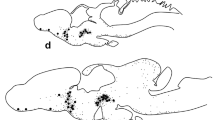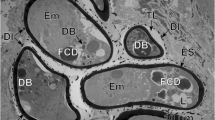Summary
The cerebral caudodorsal cells (CDC) of the pulmonate snail Lymnaea stagnalis are involved in the control of egg laying and associated behaviour by releasing various peptides. One of these is the ovulation hormone (CDCH). The cellular dynamics of this peptide have been studied using an antiserum raised to a synthetic portion of CDCH comprising the 20–36 amino acid sequence. With the secondary antibody-immunogold technique, specific immunoreactivity was found in all CDC. Rough endoplasmic reticulum and Golgi apparatus showed very little reactivity as did secretory granules that were in the process of being budded off from the Golgi apparatus. However, secretory granules that were being discharged from the Golgi apparatus, were strongly reactive. Secretory granules within lysosomal structures revealed various degrees of immunoreactivity, indicating their graded breakdown. Large electrondense granules, formed by the Golgi apparatus and thought to be involved in intracellular degradation of secretory material, were only slightly reactive. In the axon terminals secretory granules released their contents into the haemolymph by the process of exocytosis. The exteriorized contents were in most cases clearly immunopositive.
The possibility has been discussed that CDCH is cleaved from its polypeptide precursor within secretory granules during granule discharge from the Golgi apparatus; subsequently, the mature secretory granules would be transported towards the neurohaemal axon terminals where they release CDCH into the haemolymph. Superfluous secretory material would be degraded by the lysosomal system including the large electron-dense granules.
Similar content being viewed by others
References
Bliss CJ (1967) Statistics in Biology, Vol 1. McGraw-Hill, New York
Buma P, Roubos EW (1983) Calcium dynamics, exocytosis, and membrane turnover in the ovulation-hormone releasing caudodorsal cells of Lymnaea stagnalis. Cell Tissue Res 233:143–159
Buma P, Roubos EW (1986) Morphometric tannic acid and freezefracture study of peptide release by exocytosis in the neuroendocrine caudo-dorsal cells of Lymnaea stagnalis. J Electron Microsc 31:154–156
Castel M, Morris JF, Whitnall MH, Sivan N (1986) Improved visualization of the immunoreactive hypothalamo-neurohypophyseal system by use of immunogold techniques. Cell Tissue Res 243:193–204
Ebberink RHM, Loenhout H van, Geraerts WPM, Joosse J (1985) Purification and amino acid sequence of the ovulation hormone of Lymnaea stagnalis. Proc Natl Acad Sci USA 82:7767–7771
Geraerts WPM (1976) Control of growth by the neurosecretory hormone of the light green cells in the freshwater snail Lymnaea stagnalis. Gen Comp Endocrinol 29:61–71
Geraerts WPM, Bohlken S (1976) The control of ovulation in the hermaphroditic freshwater snail Lymnaea stagnalis by the neurohormone of the caudo-dorsal cells. Gen Comp Endocrinol 28:350–357
Geraerts WPM, Hogenes TM (1985) Heterogeneity of peptides released by electrically active neuroendocrine caudodorsal cells of Lymnaea stagnalis. Brain Res 331:51–61
Geraerts WPM, Joosse J (1975) Control of vitellogenesis and of growth of female accessory sex organs by the dorsal body hormone (DBH) in the hermaphroditic freshwater snail Lymnaea stagnalis. Gen Comp Endocrinol 27:450–464
Geraerts WPM, Buma P, Hogenes TM (1983) Isolation of neurosecretory granules from the neurohaemal areas of the peptidergic systems of Lymnaea stagnalis, with particular reference to the ovulation hormone producing caudodorsal cells. Gen Comp Endocrinol 53:212–217
Geraerts WPM, Maat A tcr, Hogenes TM (1984) Studies on the release activities of the neurosecretory caudodorsal cells of Lymnaea stagnalis. In: Hoffmann JA, Porchet M (eds) Biosynthesis, Metabolism and Mode of Action of Invertebrate Hormones. Springer Verlag, Berlin, pp 51–56
Geraerts WPM, Vreugdenhil E, Ebberink RHM, Hogenes, TM (1985) Synthesis of multiple peptides from a larger precursor in the neuroendocrine caudo-dorsal cells of Lymnaea stagnalis. Neurosci Lett 56:241–246
Joosse J (1964) Dorsal bodies and dorsal neurosecretory cells of the cerebral ganglia of Lymnaea stagnalis. Arch Neérl Zool 16:1–103
Joosse J (1986) Neuropeptides: peripheral and central messengers. In: Ralph C (ed) Comparative Endocrinology: Developments and Directions. saLiss, New York, pp 12–32
Kits KS (1980) States of excitability in ovulation hormone producing neuroendocrine cells of Lymnaea stagnalis (Gastropoda) and their relation to the egg-laying cycle. J Neurobiol 11:397–410
Kreiner T, Sossin W, Scheller RH (1986) Localization of Aplysia neurosecretory peptides to multiple populations of dense core vesicles. Cell Biol 102:769–782
Maat A ter, Jansen RF (1984) The egg-laying behaviour of the pond snail: electrophysiological aspects. In: Hoffmann JA, Porchet M (eds) Biosynthesis, Metabolism and Mode of Action of Invertebrate Hormones. Springer Verlag, Berlin, pp 57–62
Maat A ter, Lodder JC, Wilbrink M (1983) Induction of egg-laying in the pond snail Lymnaea stagnalis by environmental stimulation of the release of ovulation hormone from the caudo-dorsal cells. Int J Invert Reprod 6:239–247
Minnen J van, Vreugdenhil E (1987) The occurrence of gonadotropic hormones in the central nervous system and reproductive tract of Lymnaea stagnalis. An immunocytochemical and in situ hybridization study. In: Boer HH, Geraerts WPM, Joosse J (eds) Neurobiology: Molluscan Models, Mon Royal Neth Academy of Arts and Sciences. North-Holland Publishing Company, Amsterdam, Oxford, New York (in press)
Minnen J van, Reichelt D, Lodder JC (1979) An ultrastructural study of the neurosecretory canopy cell of the pond snail Lymnaea stagnalis, with the use of the horseradish peroxidase tracer technique. Cell Tissue Res 198:217–235
Roubos EW (1975) Regulation of neurosecretory activity in the freshwater pulmonate Lymnaea stagnalis (L.) with particular reference to the role of the eyes. Cell Tissue Res 160:291–314
Roubos EW (1976) Neuronal and non-neuronal control of the neurosecretory caudo-dorsal cells of the freshwater snail Lymnaea stagnalis (L.). Cell Tissue Res 168:11–31
Roubos EW (1984) Cytobiology of the ovulation-neurohormone producing caudo-dorsal cells of the snail Lymnaea stagnalis. Int Rev Cytol 89:295–346
Roubos EW, Wal-Divendal RM van der (1980) Ultrastructural analysis of peptide-hormone release by exocytosis. Cell Tissue Res 207:267–275
Roubos EW, Schmidt ED, Moorer-van Delft CM (1981) Ultrastructural dynamics of exocytosis in the ovulation neurohormone producing caudo-dorsal cells of the freshwater snail Lymnaea stagnalis (L.). Cell Tissue Res 215:63–73
Roubos EW, Ven AMH van de, Schmidt ED, Heumen WRA van (1987). Structural aspects of biosynthesis, storage and release of neuropeptides in freshwater snails. In: Boer HH, Geraerts WPM, Joosse J (eds) Neurobiology: Molluscan Models. Mon Royal Neth Academy of Arts and Sciences. North-Holland Publishing Company, Amsterdam, Oxford, New York (in press)
Shapiro HH, Wilk MB (1965) An analysis of variance test for normality. Biometry 52:591–611
Schmidt ED, Roubos EW (1987) Morphological basis for nonsynaptic communication within the central nervous system by exocytotic release of secretory material from the egg-laying stimulating neuroendocrine caudodorsal cells of Lymnaea stagnalis. Neuroscience 20:247–257
Steel RGD, Torrie JH (1960) Principles and Procedures of Statistics, McGraw-Hill, New York, Toronto
Stoeckel ME, Schimchowitsch S, Garaud JC, Schmitt G, Vaudry H, Klein MJ, Porte A (1986) Immunocytochemical evidence for intragranular processing of pro-opiomelanocortin in the melanotropic cells of the rabbit. Cell Tissue Res 242:365–370
Vreugdenhil E, Geraerts WPM, Jackson JF, Joosse J (1985) The molecular basis of the neuro-endocrine control of egg-laying behaviour in Lymnaea. Peptides 6:465–470
Wendelaar Bonga SE (1970) Ultrastructure and histochemistry of neurosecretory cells and neurohaemal areas in the pond snail Lymnaea stagnalis (L.). Z Zellforsch 108:190–224
Author information
Authors and Affiliations
Rights and permissions
About this article
Cite this article
Roubos, E.W., van de Ven, A.M.H. & van Minnen, J. Immuno-electron microscopy of formation, degradation and exocytosis of the ovulation neurohormone in Lymnaea stagnalis . Cell Tissue Res. 250, 441–448 (1987). https://doi.org/10.1007/BF00219090
Accepted:
Issue Date:
DOI: https://doi.org/10.1007/BF00219090




